Integrating strength training and conditioning.
The term strength and conditioning is thrown around a lot nowadays in the fitness industry. Many times it’s associated with high-performance coaches and experts working with only the highest caliber of athletes. However, combining these physical characteristics is not just for the elite.
Strength and conditioning may appear to be the polar opposite. Still, they are just words to describe a specific aspect of the movement. Strength can be defined as the maximum amount of force one can produce in a particular activity. They are usually associated with single max effort bouts. Conditioning can be described as the total amount of work someone can complete within a given period. However, strength and conditioning are two sides of the same coin. Both need to be assessed, trained, and improved to succeed long-term.
Solution – Concurrent Method
When setting up concurrent training, it’s essential to know the goals of each training day; otherwise, you risk not giving your body a clear stimulus to adapt to. Moreover, the order in which you plan the day is equally vital.
The easiest way to avoid these pitfalls is to order exercises based on training stimuli.
- Max Effort – Efforts over 90% 1 RM
- Relative strength focus – how much you can lift regardless of size.
- Time under tension – <20s
- Dynamic Effort – “Power” Movements/Variations (70-80%)
- Explosive and rate of force development.
- Time under tension – <10s
- Submaximal Effort – Efforts between 80-90% 1 RM
- Absolute strength and hypertrophy (functional and sarcoplasmic)
- Time under tension – <40s
- Repeated Effort – <80% 1 RM
- Hypertrophy (sarcoplasmic), endurance, and anatomical adaptation
- Time under tension – >40s
*Note – The same applies to metabolic work but for duration and intensity.
Example – 60m sprint 100% for 6.5-9 seconds
Example – 400m sprint 90-95% for 45-60 seconds
When I set up a training session, I will follow one of four ways:
| Distribution of Loading Protocols According to the Goal Selected | ||||
| Exercise Group | Power | Relative Strength | Absolute Strength | Muscular Endurance |
| Primary Exercises | Dynamic Effort | Max Effort | Max Effort | Submax Effort |
| Secondary Exercises | Max Effort / Submax Effort | Max Effort / Submax Effort | Submax Effort | Submax Effort |
| Auxiliary Exercises | Submax or Repeat Effort | Submax Effort | Submax Effort | Repeat Effort |
| Remedial Exercises | Repeat Effort | Repeat Effort | Repeat Effort | Repeat Effort |
These are in no way the only ordering options, but this can be a good starting point for experimentation and development of your own style.
Troy Wilson, Wilson Kinetic Health, BScKinH, MScKin, PKin, Team Canada Athlete, CANFund Recipient
